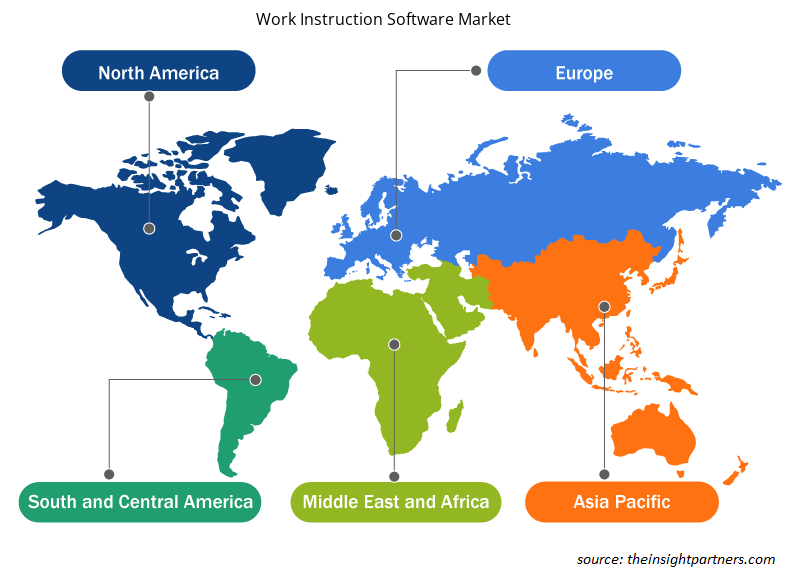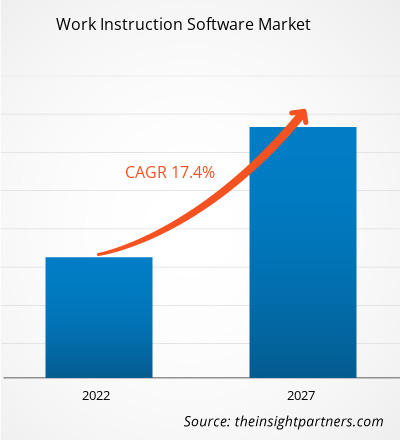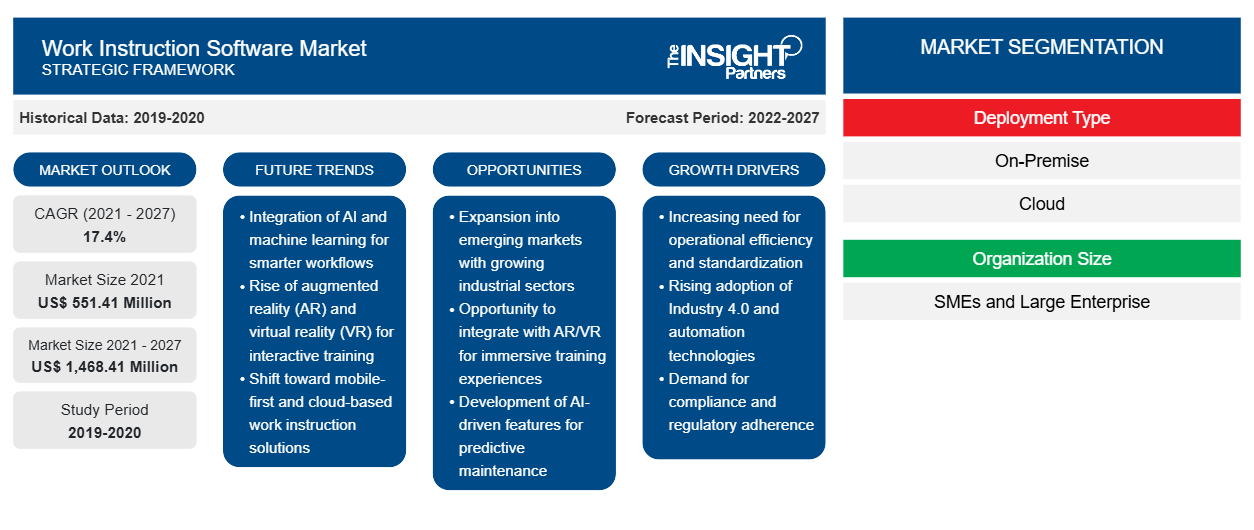Le marché des logiciels d'instructions de travail devrait passer de 551,41 millions USD en 2021 à 1 468,41 millions USD d'ici 2027. Le marché des logiciels d'instructions de travail devrait croître à un TCAC de 17,4 % au cours de la période de prévision de 2020 à 2027.
Le facteur clé qui anime le marché est l'évolution constante des complexités commerciales et de production. L'adoption d'un processus de production à modèle mixte pour améliorer la productivité globale de l'organisation crée le besoin d'une formation et d'un développement améliorés parmi les employés. Cela alimente ainsi l'adoption de logiciels d'instructions de travail dans l'ensemble du secteur manufacturier. Le besoin de formation des employés pour améliorer la productivité conduit à l'adoption de solutions technologiquement avancées dans les entreprises. La complexité accrue des processus de travail dans des secteurs tels que la fabrication, l'automobile, la santé et la vente au détail augmente la demande d'instructions de travail parmi les employés et les ouvriers pour effectuer leurs tâches de manière indépendante et efficace. Par exemple, Augmentir, Inc. propose une plateforme de main-d'œuvre connectée alimentée par l'intelligence artificielle pour aider les employés avec les flux de travail numériques et les conseils à distance tout au long du processus de travail.
Avec la pandémie de COVID-19 qui se propage à travers le monde, il devient évident que peu de personnes peuvent échapper à son ampleur, ce qui présente des défis importants pour toutes les industries. Cependant, l'application principale du logiciel se situe dans le secteur manufacturier, où il est également utilisé pour dispenser une formation aux employés sur le fonctionnement de certaines machines. Ainsi, la fermeture de toutes les unités de fabrication dans les pays développés et en développement devrait avoir un impact négatif sur la croissance du marché des logiciels d'instructions de travail .
En fonction du type de déploiement, les logiciels d'instructions de travail sont segmentés en sur site et en cloud. Les solutions basées sur le cloud devraient connaître le TCAC le plus élevé au cours de la période de prévision. En outre, le marché des logiciels d'instructions de travail en fonction de la taille de l'organisation est segmenté en PME et grandes entreprises. Les grandes entreprises représentaient la part la plus importante du marché. Le marché mondial des logiciels d'instructions de travail a été segmenté en cinq grandes régions : Amérique du Nord, Europe, APAC, MEA et SAM.
Personnalisez ce rapport en fonction de vos besoins
Vous bénéficierez d'une personnalisation gratuite de n'importe quel rapport, y compris de certaines parties de ce rapport, d'une analyse au niveau des pays, d'un pack de données Excel, ainsi que d'offres et de remises exceptionnelles pour les start-ups et les universités.
-
Obtenez les principales tendances clés du marché de ce rapport.Cet échantillon GRATUIT comprendra une analyse de données, allant des tendances du marché aux estimations et prévisions.
Informations sur le marché des logiciels d'instructions de travail
Changer la culture du travail au sein de l'organisation
La tendance croissante du BYOD (Bring Your Own Device) associée à la culture du travail à distance dans les organisations, en particulier dans les grandes entreprises, crée le besoin de solutions d'instructions de travail pour assurer le bon fonctionnement de l'organisation. La culture du travail flexible dans les organisations a conduit à l'absence des employés dans les locaux du bureau, ce qui perturbe le flux de travail, en particulier pour les employés de niveau junior qui ont besoin d'une assistance continue pour apprendre et exécuter des tâches en vue d'atteindre des objectifs. L'intégration de solutions d'instructions de travail dans les organisations permet ainsi aux employeurs de former tous les employés sans laisser la barrière physique affecter l'efficacité de la production.
Informations sur le marché basées sur le type de déploiement
En fonction du type de déploiement, le marché mondial des logiciels d'instructions de travail est segmenté en déploiement basé sur le cloud et sur site. Les logiciels d'instructions de travail basés sur le cloud connaissent une forte demande par rapport aux logiciels d'instructions de travail sur site. Le segment du cloud génère la majorité de la demande car il est comparativement moins cher et en raison de la solide infrastructure réseau des pays développés. En outre, les fournisseurs de logiciels d'instructions de travail basés sur le cloud se concentrent fortement sur le développement d'un correctif de sécurité de haut niveau afin d'éliminer le risque de cyberattaque. Ce facteur crée également une demande importante de la part des utilisateurs finaux, stimulant ainsi le marché des logiciels d'instructions de travail.
Informations sur le marché en fonction de la taille de l'organisation
En fonction de la taille de l'organisation, le marché des logiciels d'instructions de travail est segmenté en PME et en grandes entreprises. L'investissement croissant dans les infrastructures de fabrication dans les pays développés et en développement stimule considérablement la demande de logiciels d'instructions de travail parmi les PME.
Les acteurs opérant sur le marché des logiciels d'instructions de travail se concentrent sur des stratégies, telles que des initiatives de marché, des acquisitions et des lancements de produits, pour maintenir leurs positions sur le marché des logiciels d'instructions de travail. Quelques développements des principaux acteurs du marché des logiciels d'instructions de travail sont les suivants :
En avril 2020, SwipeGuide s'est associé à XMReality pour déployer des instructions de travail numériques à l'aide d'un support à distance.
En octobre 2019, Georg Fischer Signet a mis en œuvre AssemblyX de Lifecycle Technology Ltd pour l'instrumentation de travail.
Aperçu régional du marché des logiciels d'instructions de travail
Les tendances et facteurs régionaux influençant le marché des logiciels d’instructions de travail tout au long de la période de prévision ont été expliqués en détail par les analystes d’Insight Partners. Cette section traite également des segments et de la géographie du marché des logiciels d’instructions de travail en Amérique du Nord, en Europe, en Asie-Pacifique, au Moyen-Orient et en Afrique, ainsi qu’en Amérique du Sud et en Amérique centrale.

- Obtenez les données régionales spécifiques au marché des logiciels d'instruction professionnelle
Portée du rapport sur le marché des logiciels d'instructions de travail
| Attribut de rapport | Détails |
|---|---|
| Taille du marché en 2021 | 551,41 millions de dollars américains |
| Taille du marché d'ici 2027 | 1 468,41 millions de dollars américains |
| Taux de croissance annuel moyen mondial (2021-2027) | 17,4% |
| Données historiques | 2019-2020 |
| Période de prévision | 2022-2027 |
| Segments couverts |
Par type de déploiement
|
| Régions et pays couverts |
Amérique du Nord
|
| Leaders du marché et profils d'entreprises clés |
|
Densité des acteurs du marché des logiciels d'instructions de travail : comprendre son impact sur la dynamique des entreprises
Le marché des logiciels d'instructions de travail connaît une croissance rapide, tirée par la demande croissante des utilisateurs finaux en raison de facteurs tels que l'évolution des préférences des consommateurs, les avancées technologiques et une plus grande sensibilisation aux avantages du produit. À mesure que la demande augmente, les entreprises élargissent leurs offres, innovent pour répondre aux besoins des consommateurs et capitalisent sur les tendances émergentes, ce qui alimente davantage la croissance du marché.
La densité des acteurs du marché fait référence à la répartition des entreprises ou des sociétés opérant sur un marché ou un secteur particulier. Elle indique le nombre de concurrents (acteurs du marché) présents sur un marché donné par rapport à sa taille ou à sa valeur marchande totale.
Les principales entreprises opérant sur le marché des logiciels d'instructions de travail sont :
- Technologie du cycle de vie Ltée
- Gestion des connaissances Livepro
- Guide de balayage
- ScreenSteps, LLC
- Partage de connaissances visuelles Ltée.
Avis de non-responsabilité : les sociétés répertoriées ci-dessus ne sont pas classées dans un ordre particulier.

- Obtenez un aperçu des principaux acteurs du marché des logiciels d'instructions de travail
Marché des logiciels d'instructions de travail – Par type de déploiement
- Nuage
- Sur site
Marché des logiciels d'instructions de travail – par taille d'organisation
- Grandes entreprises
- PME
Marché des logiciels d'instructions de travail – par géographie
-
Amérique du Nord
- NOUS
- Canada
- Mexique
-
Europe
- France
- Allemagne
- Russie
- ROYAUME-UNI
- Italie
- Reste de l'Europe
-
Asie-Pacifique (APAC)
- Chine
- Inde
- Japon
- Australie
- Corée du Sud
- Reste de l'APAC
-
AEM
- Arabie Saoudite
- Émirats arabes unis
- Afrique du Sud
- Reste de la MEA
-
SAM
- Brésil
- Argentine
- Reste de SAM
Logiciels d'instructions de travail – Profils d'entreprises
- Dozuki
- Systèmes eFlex
- Hexagone AB
- Technologie du cycle de vie Ltée
- Gestion des connaissances Livepro
- Logiciel Optel
- ScreenSteps, LLC
- Guide de balayage
- Partage de connaissances visuelles Ltée.
- Zaptique
- Analyse historique (2 ans), année de base, prévision (7 ans) avec TCAC
- Analyse PEST et SWOT
- Taille du marché Valeur / Volume - Mondial, Régional, Pays
- Industrie et paysage concurrentiel
- Ensemble de données Excel
Rapports récents
Rapports connexes
Témoignages
Raison d'acheter
- Prise de décision éclairée
- Compréhension de la dynamique du marché
- Analyse concurrentielle
- Connaissances clients
- Prévisions de marché
- Atténuation des risques
- Planification stratégique
- Justification des investissements
- Identification des marchés émergents
- Amélioration des stratégies marketing
- Amélioration de l'efficacité opérationnelle
- Alignement sur les tendances réglementaires























 Obtenez un échantillon gratuit pour - Marché des logiciels d'instructions de travail
Obtenez un échantillon gratuit pour - Marché des logiciels d'instructions de travail